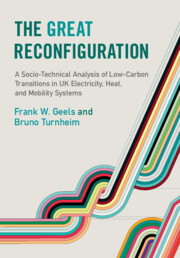 The Great Reconfiguration
The Great Reconfiguration References
Published online by Cambridge University Press: 28 April 2022
Summary
- Type
- Chapter
- Information
- The Great ReconfigurationA Socio-Technical Analysis of Low-Carbon Transitions in UK Electricity, Heat, and Mobility Systems, pp. 339 - 376Publisher: Cambridge University PressPrint publication year: 2022
- Creative Commons
- This content is Open Access and distributed under the terms of the Creative Commons Attribution licence CC-BY-NC-ND 4.0 https://creativecommons.org/cclicenses/


